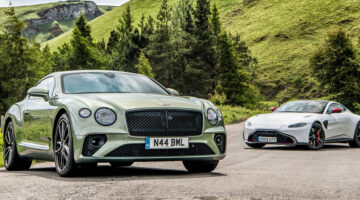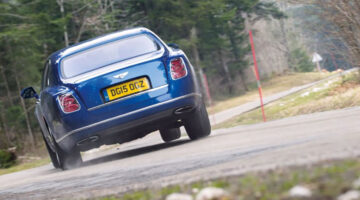| Engine | Power | Torque | 0-100kph | Top speed | Weight | Basic price |
|---|---|---|---|---|---|---|
| Inline 4cyl, supercharged, 4,398cc | 175bhp @ 3,500rpm (road), 240bhp @ 2,400rpm (race) | 'Sufficient' | c8.0 secs | c195kph (road) | 1727kg (101bhp/ton) | Sorry, not for sale |
On the road, I’m wondering if Ettore Bugatti had a point. The seating position is both lunatically high and, given the low shoulder line, feels very exposed. Our test route doesn’t help much – it’s a couple of laps around Jumeirah in very heavy rush hour traffic – but it’s enough to get pretty much everybody we pass staring and smiling. Not that you’ll notice much of that, given the concentration required.
“It’s not an easy car to jump in and drive,” Richard explains. “Even at this stage, it’s a very frisky car. It motors on well and happily cruises at around 110-120kph. It can do 160kph, although you won’t do that all too often.”
He’s not kidding. The four-speed d-type gearbox for instance has no syncro-mesh, and there’s a frighteningly small window to double declutch both up and down, the latter made trickier since quick bursts of the throttle are required to line all up: even the experts rasp the cogs from time-to-time. It’s a process made easier – good Lord – by the staggeringly light clutch pedal, but even if you somehow manage to nail each gear change, you could well be thrown by the 1930s drum brakes: impressive for their era, and still offering a reasonable amount bite, they are no match for the ABS-clad saloons around us. Time to drop back and give a bit more space.
It’s the steering wheel though that really dominates the experience. I’d expected piloting a 1727kg, 14ft long truck would be akin to piloting a ship – which, given the lack of feedback, it is – but there’s less furious sawing at the wheel than expected. There is no power steering after all, hence why the wheel is the size of a dustbin lid and why performing the 49ft turning circle requires gritted teeth and a sizable dollop of elbow grease.

Bizarrely, the Blower flows almost graceful through the corners, the positively cambered and worryingly thin tyres somehow managing to keep the sheer bulk on the nose contained. Understeer dominates of course if you take even reason speed through the corners, but an ash frame and no real weight above the footwell mean the centre of gravity is quite low. There’s still a degree of planning required ahead of the corners – “you need to gently manoeuvre rather than manhandle this machine” – but piloting the brute is much less ‘dramatic’ than I’d imagined. Even with my goggles on.
Well, that is unless the rear axle thinks about going into business for instance, a result of the chassis twisting under load, the suspension containing only as much as it can under turn-in, and more steering lock being dialled in. Once again, Richard reflects on a time when the Blower has wriggled away from him, the moral of the story being ‘don’t expect to gather up a completely sideways Bentley Blower’. Point taken.
“There’s a frighteningly small window to double declutch: even the experts rasp the cogs from time-to-time”
Which brings me, last but certainly not least, to the engine. It’s glorious, a fine cocktail of errant supercharged wail and the slow, rumbling build of momentum and acceleration. Even for a 1920s GT, the Blower is pretty sprightly once it’s up and running. The arse-ache that is the gear changes and surprisingly limited torque at the low end means the initial pick-up is fairly sedate by today’s standards, but it’s the accompanying soundtrack that continues to build with each half rev. The sound through the exhaust pipe is like a muffled machine gun, and as the speed picks up and the revs continue to rise, conversation in the open top cabin ceases altogether as the four-cylinder attempts to rupture our eardrums in half. How on earth did Birkin manage to drive this at up to 220kph without killing himself or going deaf? Even I am not looking at the speedometer…

Our drive is over considerably sooner than I’d like it to be, Richard pulling the beast to a graceful halt, fiddling with 19 switches I have no idea the purpose of, and hauling back on the handbrake while I naively wonder whether my face is matted with grime à la a 1950s Grand Prix driver. A very obvious ringing in our ears aside, conversation soon returns to normal as Richard again begins discussing the upkeep of the Blower and future models he hopes will appear in Bentley’s ever-expanding Legends collection. I must confess, with the bodywork ticking itself cool beside us, I nod along politely but am not really listening, a small smile from Richard seemingly on to me. I certainly don’t think he’ll blame me either, since following a drive in a 1930 Bentley Blower is an enormous undertaking. It’s just…fabulous, if exhausting. After all, everything, but everything – from the throttle, to the gear changes, to the braking, to turn-in, and even the simple act of getting in – requires a herculean amount of concentration, and it’s only when the Blower is up and running that you can finally relax into ‘the cruise’. Seriously, regardless of the wooden floors and hard tyres, the ride comfort is staggering.
And yet, somehow, that doesn’t feel quite right. The Blower after all was born from a desire to go faster, break new ground, and demonstrate what a very British Bentley could really do both on the road and on-track. And while success was fleeting – or in the 4 ½ Litre’s case, non-existent – it hasn’t even come close to tarnishing the legacy of this extraordinary vehicle. Even our all-too-short pootle through Dubai traffic at reasonable speeds has given me an insight I never thought I’d have into an era of Grand Prix racing long since extinct, and the men who made it possible. Weather jeans and converse, or otherwise.



